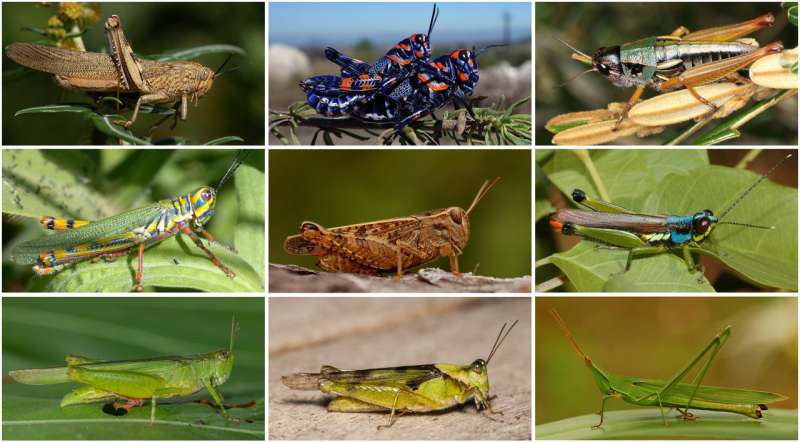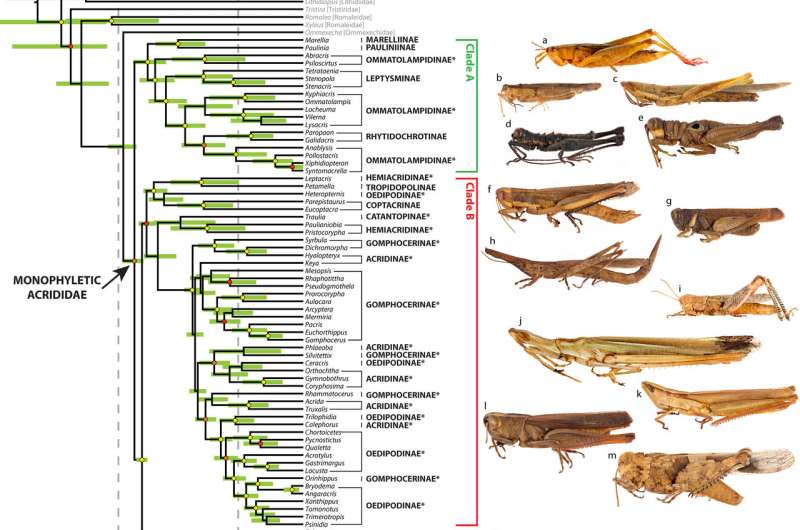Study of genetic relationships in grasshopper family Acrididae points to South American origin

Grasshoppers are one of the most ubiquitous groups of insects in the world, found everywhere from grasslands to tropical rainforests to isolated mountain ranges to sandy deserts. And now, thanks to a decade-long analysis of grasshoppers' genetic relationships, scientists have the clearest picture yet of the evolutionary pathways grasshoppers have followed to attain such diversity—and the findings put the birthplace of the broadest lineage of grasshoppers in South America, not Africa, as previously thought.
To conduct the study, a team of researchers at Texas A&M University and the Museo de La Plata in Argentina gathered grasshopper specimens from 22 countries and extracted DNA samples. Drawing from 142 grasshopper species, the researchers analyzed nucleotide sequences of both nuclear and mitochondrial genomes from those samples to learn how the various grasshopper species from around the world are related. The findings from study, the first-ever such genetic analysis of Acrididae as a whole, are published today in Insect Systematics and Diversity.
"We used the differences in nucleotides among different species to infer the relationships," says Hojun Song, Ph.D., associate professor of entomology at Texas A&M and lead author on the study. "For example, closely related species will share similar stretches of nucleotides because they share a common ancestor, but distantly related species will have more different nucleotides between them."
The resulting phylogeny—roughly akin to a family tree, but in this case for Acrididae, the largest taxonomic family of grasshoppers—gives science a new, more nuanced understanding of how grasshoppers have evolved. It shows that grasshoppers within Acrididae descended and diversified from one common ancestor, but many of the currently recognized subfamilies are deemed "paraphyletic," meaning they couldn't be narrowed down to their own single common ancestor on the Acrididae family tree.
Historically, grasshopper taxonomy has been difficult due to convergent evolution, in which organisms that are not closely related evolve similar external features and appearance as they adapt to similar environments. Thus, taxonomists commonly grouped unrelated species into the same groupings due to their similar convergent body forms. Meanwhile, often only minute physical differences exist between species, leading taxonomists to rely on male grasshopper genitalia as the leading identifier to differentiate species. But Song and colleagues say their genetic analysis offers a new lens through which taxonomists may look to revisit grasshopper classification.
"There are some subfamilies, such as Catantopinae and Hemiacridinae, that have been considered taxonomic dumping ground for many decades," Song says. "This means that a lot of unrelated groups have accumulated in these artificial groupings. Showing the paraphyletic nature of these groups is the first step to reclassify taxonomy, and we foresee that there would be some major shifts in grasshopper classification in the near future."

Perhaps the most significant of those shifts is the determination that the common ancestor of grasshoppers in the Acrididae family lived in South America, not Africa. Scientists used to think that Acrididae originated from Africa because many other related families exist in Africa and because the South American grasshoppers had not been fully explored. The genetic analysis included samples from eight species outside but related to those in Acrididae. Among those "outgroup" species sampled, the ones deemed most closely related in the genetic analysis are all native to South America. The researchers also studied fossil specimens to calibrate the age of certain grasshopper subfamilies, and they found that the earliest diverging lineage within the Acrididae family is also primarily found in South America.
"These relationships collectively point to the South American origin of this cosmopolitan family," Song says. "Our time-calibrated tree shows that Acrididae originated in the Paleocene of the Cenozoic period, 59.3 million years ago."
At that point in history, the continents of South America and Africa were already separated but closer compared to their current positions, and northern Africa was covered in tropical rainforests, much like the Amazonian region in South America. Song and colleagues propose that Acrididae's single ancestor first branched off from its relatives in South America and then traversed the Atlantic sometime around 57 million years ago. Those grasshopper "colonists" found suitable habitat in Africa and then rapidly radiated and diversified across Africa and into Europe and Asia. After that, the genetic analysis points to at least three subsequent recolonization events in which grasshoppers traversed back to North America, furthering their global spread and diversification.
Given grasshoppers' iconic status in the insect realm, Song says he was surprised that no one had previously attempted to build a phylogeny of Acrididae through molecular genetic techniques. The new effort was made possible by grants, dating back to 2008, from the National Science Foundation for Song's research into the evolution of Orthoptera, the insect order comprising grasshoppers and their relatives such as locusts, crickets, and katydids. Before such a phylogenetic project can even begin, years of field work is necessary to collect the broad range of sample species needed, aided by contributions from international collaborators, as well.
"It is not an overstatement to say that this study took 10 years to complete," Song says. "This type of research requires extensive taxon sampling to appropriately represent the known diversity, which is probably the most challenging—but also the most exciting—aspect of any large-scale phylogenetic study."
Acrididae is known to contain approximately 6,700 species. And so, while the new genetic analysis is the most detailed yet on the grasshopper family, the species it sampled constitute only 2 percent of Acrididae's full diversity. Song says he and his colleagues are eager to further build out the grasshopper family tree.
"We plan to increase the taxon sampling in the future and use more phylogenetic markers to build a more comprehensive phylogeny. At the same time, we plan to reclassify major groups within the family so that the classification would reflect monophyletic groups," he says.
More information: Hojun Song et al, Evolution, Diversification, and Biogeography of Grasshoppers (Orthoptera: Acrididae), Insect Systematics and Diversity (2018). DOI: 10.1093/isd/ixy008
Provided by Entomological Society of America



















